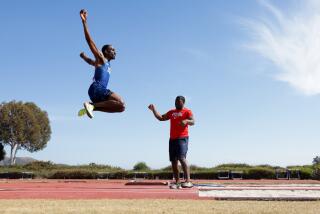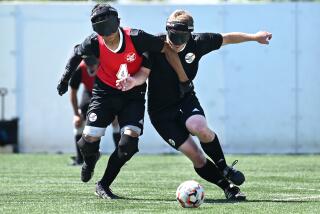Expanding the Realm of the Possible : Exploration: Blind NASA scientist helps handicapped students understand the importance of reaching for the stars.
The scene Friday in Downey was a close encounter of a special kind.
A blind man was trying to explain to an audience of deaf teen-agers how to distinguish the sound that comes from pulsars from other outer space noise picked up by radio telescopes aimed at the skies.
And he was succeeding.
Communications challenges are nothing new to Kent Cullers, the man who has designed equipment that may someday allow extraterrestrials to communicate with earthlings.
Sightless since birth, Cullers, 41, is a NASA scientist. In October, he will help manage the United States’ 10-year Search for Extraterrestrial Intelligence program when it is launched from Mountain View, Calif.
Cullers’ task Friday at Selaco High School in Downey and at Mayfair High School in nearby Lakewood was more down-to-earth, however. He was meeting with handicapped teen-agers to assure them that there is nothing that can keep them from reaching for the stars.
Along with deaf youngsters, the crowd of 120 at Selaco High included autistic teen-agers and those with other learning disabilities. A slightly smaller crowd at Mayfair High included blind high school students.
Sophisticated research equipment now used by scientists can be adapted for use by both the deaf and the blind, Cullers told the youngsters. Scanners can convert visual data into the spoken word. Conversely, sounds can be digitized onto computer screens and graphs.
“I certainly don’t think you have to hear to do this job,” he told the eager youngsters at Selaco as interpreter Toby Royce signed a translation.
To the blind students at Mayfair High, he added: “I don’t think my blindness has had anything one way or another to do with my job.”
Cullers played a tape recording of pulsar sounds from a radio telescope to demonstrate to both groups what types of space signals researchers will be listening to during the upcoming 10-year, $100-million extraterrestrial eavesdropping effort. Using a pocket-size shortwave radio, Cullers demonstrated the hiss of radio static that he hopes his equipment will filter out.
For the deaf students, he waved his hand in time to the thumping sounds emitted by the pulsar. He wiggled his hand back and forth crazily to illustrate the static.
Cullers couldn’t see it. But the students’ faces lit up as the sign-language interpreter repeated his explanation of super novas and his declaration that there are “100 billion places just in this galaxy where life may be happening.”
“Maybe there’s one signal that says, ‘Hi there, we’re the aliens!’ That’s what we’re hoping for,” Cullers said, grinning.
At both schools, youngsters crowded around the scientist after his hourlong talks, which were arranged by the Los Angeles County Office of Education. Cullers was invited by Elise Sandiford, a career counselor for handicapped students whose husband grew up across the street from Cullers in Temple City.
“At first I felt sorry for him. I thought, oh my gosh, he’s blind. But he’s so smart. And he’s accomplished so much,” said Jeff Cypert, a 17-year-old deaf Selaco High senior from East Los Angeles.
Seventeen-year-old Claremont High School sophomore Dave Webster of San Dimas, who is blind, said Cullers proves that the blind can do more than “just sit at home saying, ‘Poor me.’ ”
Todd Struve, a 17-year-old Claremont junior from Upland, said he would not soon forget the lesson Cullers taught him.
“Some day down the road when I’m stuck in a rut I’m going to look back on this day,” Struve vowed. “I can accomplish what I set out to do.”






